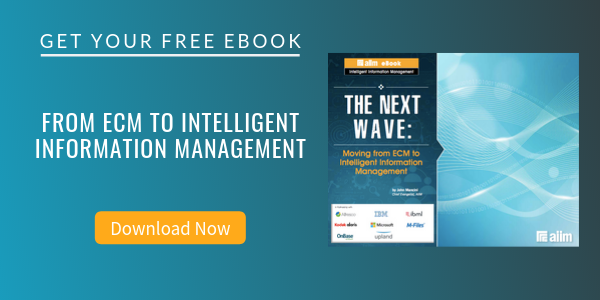
8 Ways to Enhance Knowledge Worker Productivity
PDF | Productivity | Intelligent Information Management (IIM)
How much time does your organization waste each week assembling and compiling information?
It is now common knowledge that information chaos is a major source of stress to individual knowledge workers and a major cost to their companies and the overall economy. At the latest estimate, the cost to the US economy is $960 billion in salaries alone, which corresponds to a cost of $7 million per year for companies with 500 knowledge workers.
Some of the images offered by organizations such as IDC and AIIM to illustrate the sheer amount of information are highly graphic – the amount of paper received being equal in weight to all a company’s employees put together conjures up a wonderful scene to re-enact in the parking lot. Or, the fact that year’s worth of information is equivalent to 12 stacks of books stretching from the Earth to the Sun. Or, that in 2010, the online digital data we produce will be 16 million times more than every book ever written.
How can we apply some Lean principles to reduce waste and restore satisfaction in knowledge worker productivity?
How To Improve the Productivity of Knowledge Workers
-
Provide a tool to enable gathering multiple pieces of information into one source file.
Just imagine the time you would save if your eDocument application allowed you to combine pages from your Excel, Word, and PowerPoint documents in one file with a simple drag and drop and converted them to PDF automatically for you. What if you could also keep a useful record of web pages you visit and find useful by virtually printing the web page using an eDocument application print driver to either a PDF or XPS file. Better than bookmarking a URL that might not be there next time you visit.
-
Confirm you have the information you need.
An eDocument application should allow you to view multiple documents at the same time in one viewing pane. The time saved in opening multiple applications soon adds up to your benefit.
-
Remove the obstacle of missing applications and file formats that can’t be opened.
Your eDocument application should handle multiple file-formats - you shouldn’t need to have the latest version (or any version) of MS Office installed in order to access the information.
-
Save time searching through documents.
Yes, good enterprise search tools narrow down the options, but eventually, it takes a user to decide if what’s on-screen is the information they need. Find an eDocument application that provides a flick-based document viewer that allows you to browse through large documents quickly to find what you want by flicking through pages on screen like you would with a printed document. It saves time and money on printing out large documents too.
-
Bring the feature to the user, not the user to the feature.
Knowledge workers may have many applications installed, but research shows that they will spend a significant amount of their time in just one or two applications. And the most likely #1 application will be their word processor. You really need your eDocument application to provide an add-in for the common Microsoft Office tools (Word, Excel, and PowerPoint) that enables you to create PDFs in one click using the MS Office toolbar.
-
Repurpose documents for sharing, web, printing with the right level of security.
Too often, PDFs are saved without the right Open or Security settings. A Finish Document Wizard in your eDocument application ensures the right settings are applied by guiding the user through the process, step-by-step. It allows you to apply a password that must be entered every time a document is opened. You can also apply a password that controls the security settings for Printing, copying text and graphics, document assembly, adding or removing comments.
-
Support editing of PDF files.
PDFs are becoming the de-facto “format of convergence” for sharing information. Knowing that the end-recipient can open and read your information is a key requirement. But simple PDF Readers just overcome the first obstacle. Good eDocument applications allow you to edit, comment, and review PDFs – the editing tools are there on the page, so you don’t need to waste time searching for them.
-
Convert PDF to Word for more extensive redrafting.
You’ve been sent the latest version of a document as a PDF file. You notice that there’s a mistake or something that can be improved. What do you do? You can annotate the PDF file with a comment and send it back to the author for editing. Or, you can use your eDocument application to convert the PDF to Word, make the changes yourself, and send back the finished article to the author.
About John Mancini
John Mancini is the President of Content Results, LLC and the Past President of AIIM. He is a well-known author, speaker, and advisor on information management, digital transformation and intelligent automation. John is a frequent keynote speaker and author of more than 30 eBooks on a variety of topics. He can be found on Twitter, LinkedIn and Facebook as jmancini77. Recent keynote topics include: The Stairway to Digital Transformation Navigating Disruptive Waters — 4 Things You Need to Know to Build Your Digital Transformation Strategy Getting Ahead of the Digital Transformation Curve Viewing Information Management Through a New Lens Digital Disruption: 6 Strategies to Avoid Being “Blockbustered” Specialties: Keynote speaker and writer on AI, RPA, intelligent Information Management, Intelligent Automation and Digital Transformation. Consensus-building with Boards to create strategic focus, action, and accountability. Extensive public speaking and public relations work Conversant and experienced in major technology issues and trends. Expert on inbound and content marketing, particularly in an association environment and on the Hubspot platform. John is a Phi Beta Kappa graduate of the College of William and Mary, and holds an M.A. in Public Policy from the Woodrow Wilson School at Princeton University.



